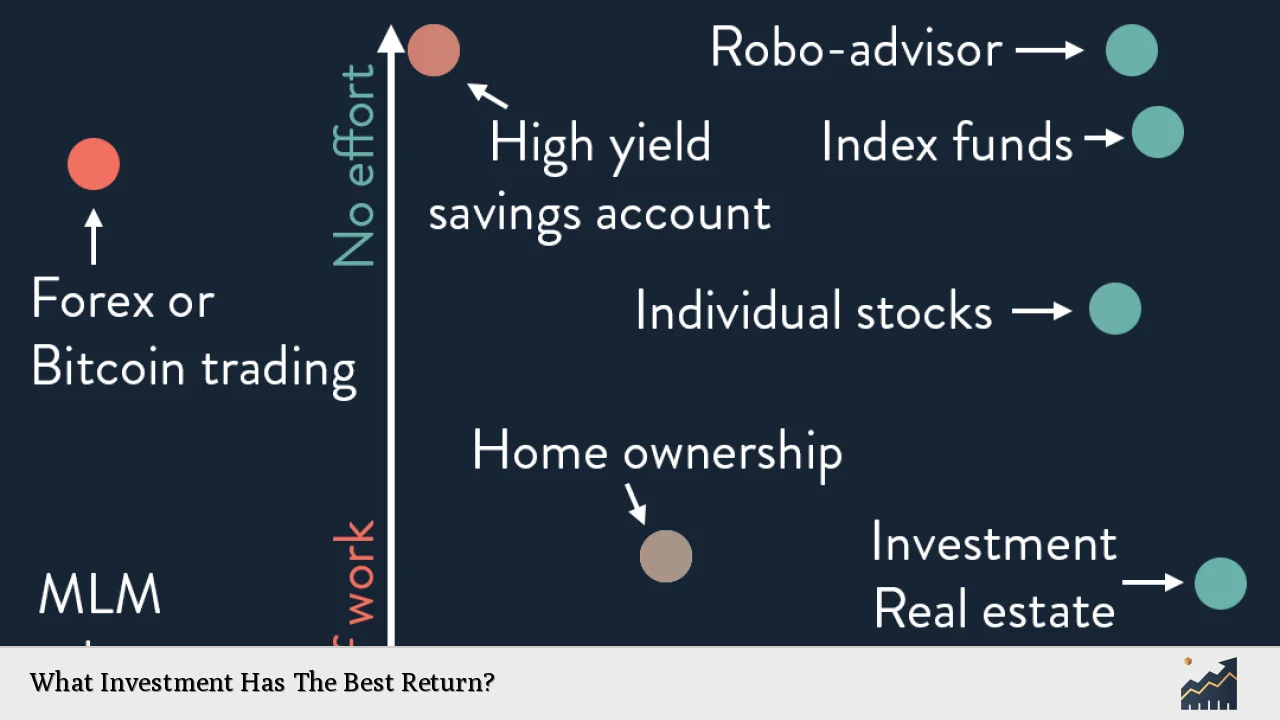Investing is a crucial aspect of financial planning, and understanding which investments yield the best returns is essential for maximizing wealth. Various investment vehicles can provide different levels of risk and return, making it vital to evaluate options based on individual financial goals and market conditions. In this article, we will explore several investment types, their potential returns, and strategies for optimizing your investment portfolio.
| Investment Type | Potential Returns |
|---|---|
| Stocks | 7-10% annually |
| Bonds | 2-5% annually |
| Real Estate | 8-12% annually |
| Mutual Funds | 6-10% annually |
| Cryptocurrencies | Variable, high volatility |
Understanding Investment Returns
Investment returns refer to the profit or loss generated by an investment over a specific period. The return can be expressed as a percentage of the initial investment amount. Understanding the various factors that influence these returns is critical for making informed investment decisions.
The primary types of returns include capital gains, which occur when an asset’s price increases, and income, which comes from dividends or interest payments. The risk associated with each investment type significantly impacts potential returns; typically, higher-risk investments offer the possibility of higher returns.
Additionally, market conditions play a vital role in determining investment performance. Economic indicators such as interest rates, inflation rates, and overall market trends can influence how well an investment performs. Investors should stay informed about these factors to make strategic decisions.
Types of Investments with High Returns
Investors often seek assets that provide high returns. Here are some popular options:
- Stocks: Historically, stocks have provided average annual returns of around 7-10%. Investing in individual stocks or index funds can lead to significant capital appreciation over time.
- Real Estate: Real estate investments can yield returns between 8-12% annually through property appreciation and rental income. This asset class also provides a hedge against inflation.
- Cryptocurrencies: While highly volatile, cryptocurrencies can offer substantial returns. However, they carry significant risk due to price fluctuations and regulatory uncertainties.
- Mutual Funds: These funds pool money from multiple investors to purchase a diversified portfolio of stocks or bonds. They typically yield returns between 6-10% annually.
- Bonds: Although generally considered safer than stocks, bonds provide lower returns, usually around 2-5% annually. However, they can offer stability in a diversified portfolio.
Factors Influencing Investment Returns
Several factors impact the performance of investments:
Market Conditions
Market conditions are influenced by economic indicators such as GDP growth, unemployment rates, and consumer spending. A strong economy generally leads to higher stock prices and better investment returns.
Interest Rates
Interest rates have a direct impact on bond prices and stock valuations. When interest rates rise, bond prices typically fall, while higher rates may also affect corporate profits and stock prices negatively.
Inflation
Inflation erodes purchasing power and can impact real returns on investments. Investments that do not keep pace with inflation may result in negative real returns over time.
Investment Horizon
The length of time an investor plans to hold an asset influences potential returns. Longer investment horizons allow for compounding growth and can mitigate short-term market volatility.
Risk Tolerance
An investor’s risk tolerance plays a critical role in determining suitable investments. Higher-risk investments may offer greater potential returns but also come with increased volatility.
Strategies for Maximizing Investment Returns
To achieve optimal returns on investments, consider implementing these strategies:
- Diversification: Spread investments across various asset classes to reduce risk while maximizing potential returns.
- Long-Term Perspective: Adopt a long-term investment strategy to take advantage of market growth over time and minimize the impact of short-term fluctuations.
- Regular Contributions: Consistently invest additional funds into your portfolio to benefit from dollar-cost averaging and compounding growth.
- Rebalancing: Periodically review and adjust your portfolio to maintain your desired asset allocation based on changing market conditions or personal goals.
- Research and Education: Stay informed about market trends, economic indicators, and specific investments to make educated decisions that align with your financial objectives.
Evaluating Investment Performance
To determine which investments are performing well, investors should regularly evaluate their portfolios. Key performance indicators include:
- Total Return: This includes capital gains plus any income generated from the investment.
- Risk Adjusted Return: Assessing return relative to the level of risk taken helps identify whether an investment is worth pursuing compared to others with similar risk profiles.
- Benchmark Comparison: Comparing investment performance against relevant benchmarks provides context for evaluating success or underperformance.
FAQs About Investment Returns
FAQs About What Investment Has The Best Return?
- What is the average return on stocks?
The average annual return on stocks is approximately 7-10%. - Are cryptocurrencies a good long-term investment?
Cryptocurrencies can be highly volatile; while they may offer high returns, they also carry significant risks. - How does real estate compare to stocks in terms of return?
Real estate typically offers annual returns between 8-12%, which can be competitive with stock market returns. - What factors affect bond prices?
Bond prices are primarily influenced by interest rates and inflation expectations. - How important is diversification in investing?
Diversification helps reduce risk while potentially enhancing overall portfolio returns.
In conclusion, identifying which investment has the best return involves evaluating various options based on individual risk tolerance, market conditions, and personal financial goals. Stocks and real estate often emerge as top contenders for high returns, but investors should consider their unique circumstances when making decisions. By employing effective strategies such as diversification and maintaining a long-term perspective, investors can optimize their portfolios for better performance over time.

